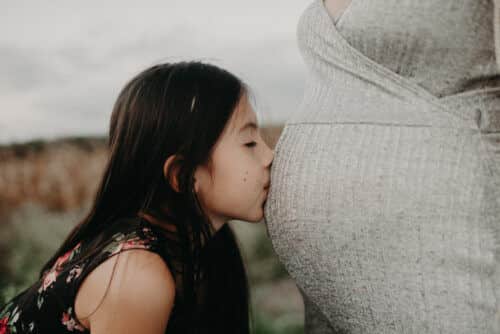The researchers: Pregnant women should take strict precautions in order not to contract the virus and not to infect their baby. The woman and the baby got relatively mildly ill and were released to their home

The lead researcher says that although the mother and baby recovered, the case highlights the importance of limiting exposure to COVID-19 for pregnant women.
A pregnant mother who tested positive for the coronavirus and had COVID-19 passed the virus to her premature baby, doctors in Texas report. Both were treated and recovered.
The case, detailed in an article published last month in The Pediatric Disease Journal, adds to the growing body of evidence that the SARS-CoV-2 virus can be transmitted in utero. The findings also highlight the importance of limiting exposure of pregnant women to the virus.
"With the increase in the number of patients, it is very important to highlight the finding and warn that mothers and babies can be infected and fall ill with Corona. Infection can occur during pregnancy, and pregnant women need to protect themselves," says Dr. Amanda Evans, M.D., assistant professor of pediatrics specializing in infectious diseases at Southwestern University. and senior author of the article. "We don't know if there are any long-term effects of COVID-19 infection in infants."
Although more than 20 million people worldwide have been infected with SARS-CoV-2 – the virus that causes COVID-19 – there is only limited data on how the virus affects pregnant women. An early study conducted in Wuhan, China, concluded that mother-to-baby transmission of SARS-CoV-2 was unlikely, as researchers found no copies of the virus in any amniotic fluid, cord blood or breast milk. However, a handful of more recent studies have suggested that there may be isolated cases in which such an infection occurs during pregnancy.
In the case described in the study, a woman who was 34 weeks pregnant visited the emergency room with signs of early labor and was admitted to the COVID unit at Parkland Hospital, after testing positive for the SARS-CoV-2 virus. While she did not have typical respiratory symptoms associated with COVID-19, she did have fever and diarrhea, which indicated a possible viral infection.
"At that time, we did a universal screening of everyone who came to the hospital for the most common symptoms of COVID-19, including respiratory symptoms and gastrointestinal symptoms," says Dr. Wilmer Moreno, assistant professor of obstetrics and gynecology at UTSW who was involved in the study.
The woman, who did not know how she contracted the virus, remains hospitalized for her COVID-19 diagnosis. Three days after the start of hospitalization, she experienced water loss. After a birth process that lasted eight hours in early May, she gave birth to a healthy daughter weighing 3.2 kg. kilo.
"The baby did well for the first 24 hours," says Julied Sissman, MD, an associate professor of pediatrics who treated the baby and lead author of the paper. "But since she was born prematurely to a mother positive for COVID-19, we decided to hospitalize her in a special area away from other babies.
24 hours after birth, the newborn pup developed a high fever and showed signs of respiratory distress, including rapid breathing and low blood oxygen levels. Sisman and her colleagues conducted tests to detect viruses and bacteria. While other tests came back negative, the COVID-19 test was positive both 24 and 48 hours after birth.
"At that time, the medical knowledge was shredding that transmission doesn't happen in the womb, so we really didn't expect it," Sisman said.
To help pinpoint how and when mother-to-baby transmission occurred, Prof. Dinesh Raheja, professor of pathology at UTSW, analyzed the placenta left over from the pregnancy.
"We found signs of inflammation and evidence that the baby was stressed," says Rahja. "Then, to look for the virus, we did tests beyond those that are routinely done."
He and his colleagues first examined thin slices of the placenta under an electron microscope, and noticed structures that looked like viruses. They then tested small samples of the placenta for the SARS-CoV-2 virus. Currently available commercial tests for the COVID-19 virus rely on body fluids rather than solid tissue to detect the virus. That's why Rahja used a test originally developed for the SARS virus from 2003. The immunohistochemical test, adapted to the new corona virus, allowed the pathologist to identify the nucleocapsid protein of the SARS-CoV-2 virus.
Neither mother nor baby had symptoms severe enough to warrant treatment other than oxygen and fluids, and both made a full recovery. The baby stayed in the hospital for three weeks and then was released.
to the hospital's announcement
More of the topic in Hayadan:
- Researchers from the Hebrew University and Hadassah: the risk of a renewed outbreak of the corona virus in Israel is increasing
- When will there be a vaccine for the corona virus? Four scenarios
- Researchers offer a new approach to dealing with the corona virus: putting the immune system into action even before the body is attacked
- The science behind the corona virus

One response
What do the destruction of coral reefs, the damage to the ozone and the corona virus have in common?
Those who think that bats are the source of the corona virus should think again.
There is no negative natural phenomenon in our world that does not originate from man.
The point is only how sophisticated are those glasses in which we have the ability to explore reality.
While the destruction of coral reefs is done both physically and as a result of the damage to the ozone that originates from human actions, the corona phenomenon is the result of more hidden connections at the level of intentions and thoughts between humans, the most developed level of nature.
Our connections humans still do not have the tools and abilities to discover them.